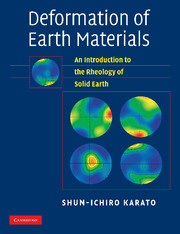Book contents
- Frontmatter
- Contents
- Preface
- Part I General background
- Part II Materials science of deformation
- Part III Geological and geophysical applications
- 17 Composition and structure of Earth's interior
- 18 Inference of rheological structure of Earth from time-dependent deformation
- 19 Inference of rheological structure of Earth from mineral physics
- 20 Heterogeneity of Earth structure and its geodynamic implications
- 21 Seismic anisotropy and its geodynamic implications
- References
- Materials index
- Subject index
- Plate section
17 - Composition and structure of Earth's interior
Published online by Cambridge University Press: 05 June 2012
- Frontmatter
- Contents
- Preface
- Part I General background
- Part II Materials science of deformation
- Part III Geological and geophysical applications
- 17 Composition and structure of Earth's interior
- 18 Inference of rheological structure of Earth from time-dependent deformation
- 19 Inference of rheological structure of Earth from mineral physics
- 20 Heterogeneity of Earth structure and its geodynamic implications
- 21 Seismic anisotropy and its geodynamic implications
- References
- Materials index
- Subject index
- Plate section
Summary
The current status of our understanding of the structure and composition of Earth and other terrestrial planets is summarized with the emphasis on those issues that are critical to the rheological properties and the dynamics/evolution of terrestrial planets. A brief summary of the methods of inference of pressure, temperature and major element compositions is presented together with some major results. Current knowledge of the mineralogical composition of the crust, mantle and core is briefly reviewed together with a review of our knowledge on the water content and grain size.
Key words Adams–Williamson equation, adiabatic temperature gradient, Bullen parameter, crust, mantle, core, transition zone, lower mantle, D″ layer, inner core, pyrolite model, chondrite model.
Gross structure of Earth and other terrestrial planets
This chapter provides a brief review of the structure and composition of Earth and other planetary interiors. The emphasis is on the issues that are critical to the understanding of rheological properties, and hence the dynamics and evolution of terrestrial planets. Several methods are currently used to infer the interior of Earth and other planets. (1) The gravity field outside a planet and related geodetic measurements provide constraints on the average density and the mass distribution in that planet. (2) The magnetic field outside a planet provides some clue as to the dynamics of planetary interiors. The magnetic field caused by remnant magnetization of crusts provides hints as to the dynamics of a planet in the past.
- Type
- Chapter
- Information
- Deformation of Earth MaterialsAn Introduction to the Rheology of Solid Earth, pp. 305 - 322Publisher: Cambridge University PressPrint publication year: 2008
- 1
- Cited by



